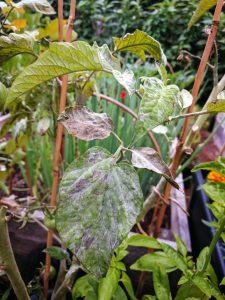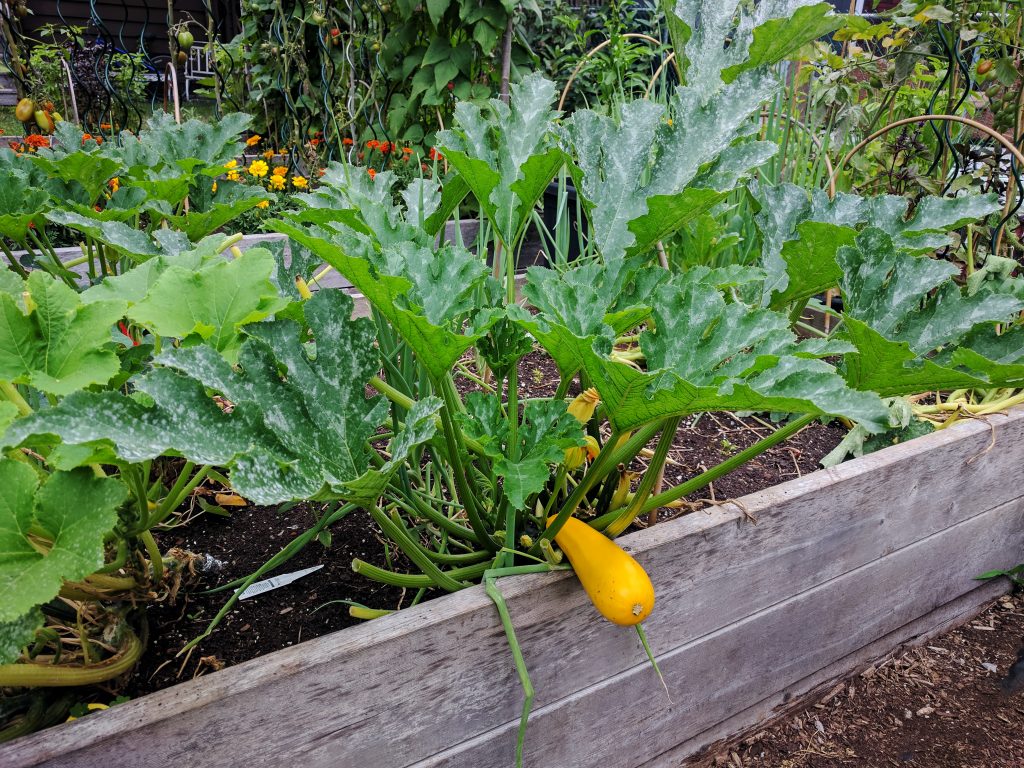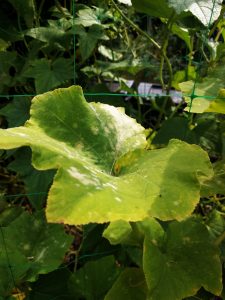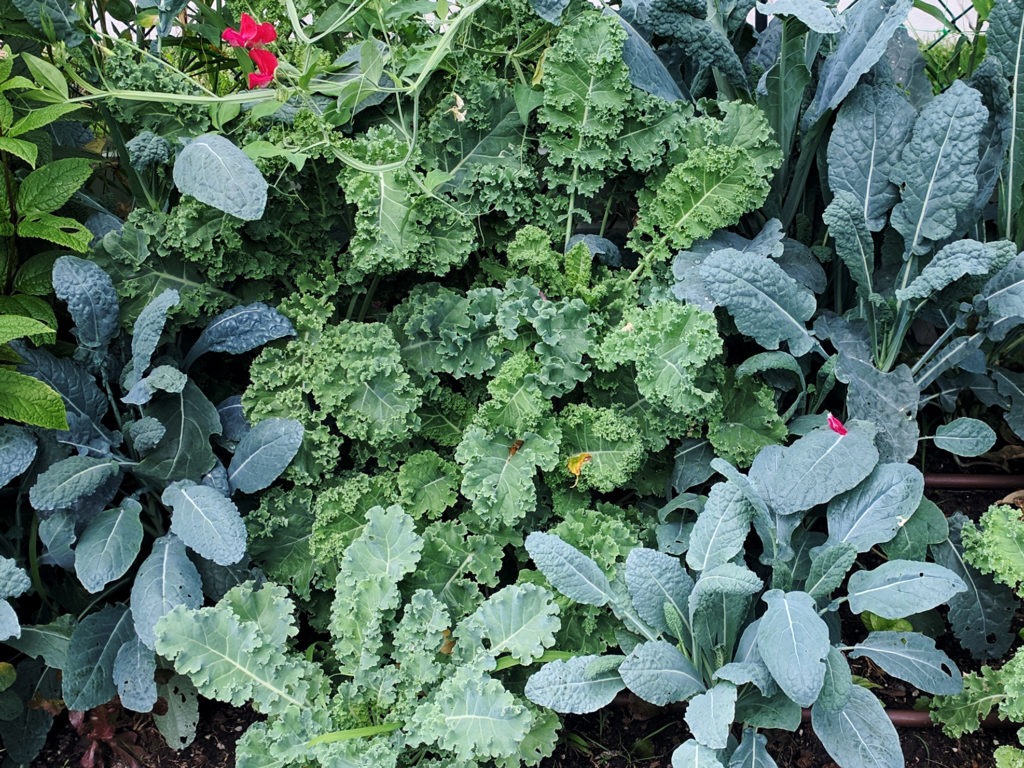After the compost tea party…
Every year we like to experiment with something new at the BUFCO Lab. This winter Arlene, BUFCO’s lead gardener Julia, and I took the Organic Master Gardener course from Gaia College which introduced us to Dr. Elaine Ingham‘s experiments with compost tea applications and how they could prevent plant feeding fungi like powdery mildew.

Source: Dr. Elaine Ingham via Gaia College
We’ve always struggled with powdery mildew on zucchini and tomatoes at the BUFCO Lab, so when Arlene heard about the benefits of foliar applications of compost tea, she immediately tried spraying a compost tea concoction on a rosemary plant covered with powdery mildew. Lo-and-behold, the compost tea appeared to reverse the disease.
Compost tea – 1; Powdery mildew – 0!!!
So when we saw the first signs of powdery mildew on our otherwise prolific tomatoes last month, we knew we had to try applying compost tea to the leaves and stems.
Method
We applied three batches of homemade compost tea within a 2 week period:
| Batch | Date Created | Compost Source | Brew Location | Brew Time | Date Applied |
| 1 | July 11 | Homemade Vermicompost | Basement | 72 hours | July 14 |
| 2 | July 15 | Homemade Vermicompost Leachate | Basement | 72 hours | July 17 |
| 3 | July 22 | Commercial Vermicompost (Jocelyn’s Soil Booster) |
Outside | 24 hours | July 23 |
Vermicompost is worm poop which is known to be chock full of beneficial worm gut bacteria. Vermicompost leachate is the concentrated liquid that drips from our worm-poop-making contraption. To each batch of our home brew, we add liquid kelp, sea minerals, and molasses as described in my previous post.
Now, this was a completely exploratory endeavour by novices and meets zero criteria for being considered science. For starters, we applied the compost tea to all plants without using a control group to test against our treatment group, so there’s no way we can know what would have happened if we didn’t apply compost tea. Then, we applied different recipes consecutively and at different stages of powdery mildew progression, so it’s not clear whether a specific recipe is ineffective, beneficial, or outright detrimental. Needless to say, our experimental methods are by no means a replication of Dr. Ingham’s own studies but are inspired by her great work.
Results
Did it reverse powdery mildew? Unfortunately not.
The first signs of powdery mildew were spotted on tomatoes and zucchini on July 8th and the affected leaves were pruned immediately. We knew that Dr. Ingham’s suggested application was preventative, not curative but we wanted to try anyway. The first application of compost tea was on July 14th, almost a week later.
  |
Powdery mildew which began as tiny white spots on our tomato leaves spread all over the leaves and progressed to the stems. In the end, the disease weakened our tomato bed so much that we had to harvest what we could and remove and destroy the diseased plant material… so it looks like powdery mildew won this time.
Did it prevent powdery mildew? Not really.
Our butternut squash did not have powdery mildew at the start of the treatment period, but the powdery mildew ended up spreading to them despite having preventative applications. Interestingly, the powdery mildew did not spread to the cucumber that were directly beside the squash.
|
|
|
Did it prevent other diseases? Perhaps.
Our kale that was struggling from cabbage moth worm damage came back nicely. Peppers, eggplants, and okra (which are in the same plant family as tomatoes) remained healthy.
Did it make the plants more resilient despite succumbing to the disease?
That is, if we didn’t apply the compost tea, would the affected plants be doing worse? Our tomatoes and zucchini continued producing fruit despite being affected by the powdery mildew.

Analysis
A couple weeks ago, we got to meet Dr. Elaine Ingham during a workshop at Glen Road Organics and it was a game changer! She pointed out the mistakes we made in Batch #1 and #2, but by the time we implemented her suggestions in Batch #3, we might have been too late.
| Batch | Mistakes |
| 1 |
|
| 2 |
|
| 3 |
|
Conclusions
So there we have it: Powdery Mildew – 1; “Compost Tea” – 1.
Our fascination with compost tea was fueled by a miraculous healing of powdery mildew on a potted rosemary plant this winter after a foliar application of diluted vermicompost leachate. Miraculous because, looking back, we did nothing right on that first application: we used vermicompost leachate (which may or may not be anaerobic), we did not aerate the tea (aeration is essential to multiplying aerobic bacteria), we did not feed the bacteria (organisms are not active), and the mildew had already been established for weeks … yet it seemed to work! Now, we’re using the right compost, we have a bubbler, brewing for the right time and at the right place, and yet some of the treated plants seem to be doing worse off. Life is such a mystery!
But we’re far from giving up. One of the goals for BUFCO Lab is to experiment and learn so we can grow healthy gardens for our clients. Experiments are, by nature, fueled by curiosity and it would be arrogant of us to expect nature to yield to our agenda. Whether I am a scientist, a gardener, or anything in between… I’m simply asked to observe, tweak, expect the unexpected, not take things personally, and enjoy the relationship I am fostering with nature.
Stoic thoughts aside, the biggest compost tea sin we committed was by far not verifying the microbiology in our tea with a microscope. During our time with Dr. Elaine Ingham last month, she shared a story about a garden that did not thrive even after several compost tea applications because the bacteria, nematodes, and fungi did not exist in at the right proportions. So, if anything, this experiment indicates that brewing an effective batch of compost tea really does requires a microscope. Lucky for us, because now we get to purchase a new toy!
References
- Ingham, E. (2005). The Compost Tea Brewing Manual [5]. Retrieved from http://ecologiesurleweb.free.fr/docs/Docs_agir/Lombricomposteur/Brew Manual compost tea.pdf

